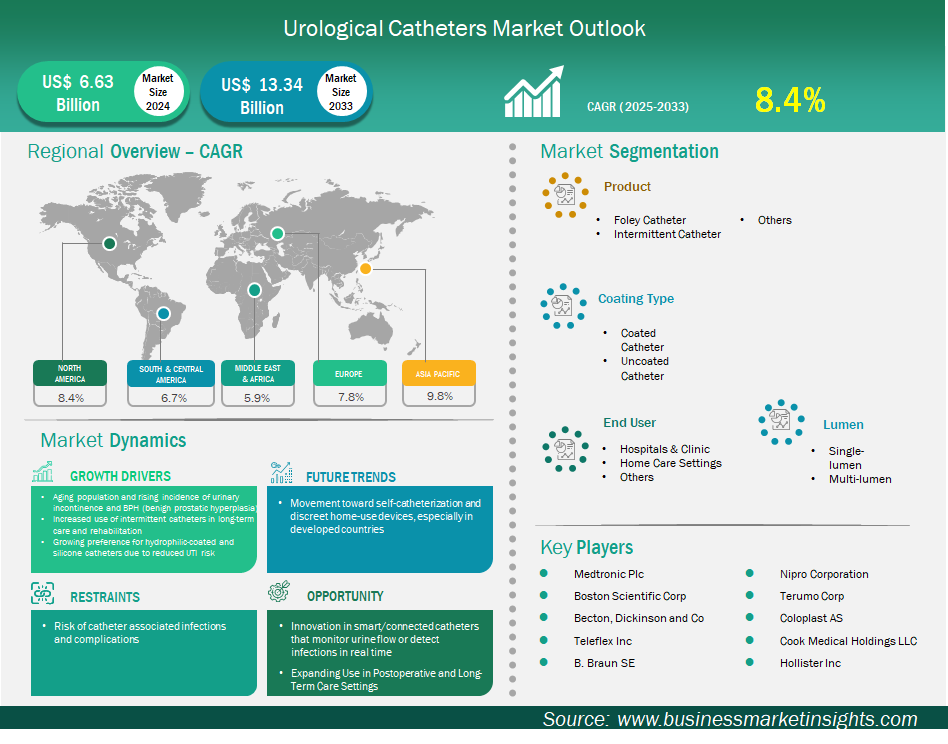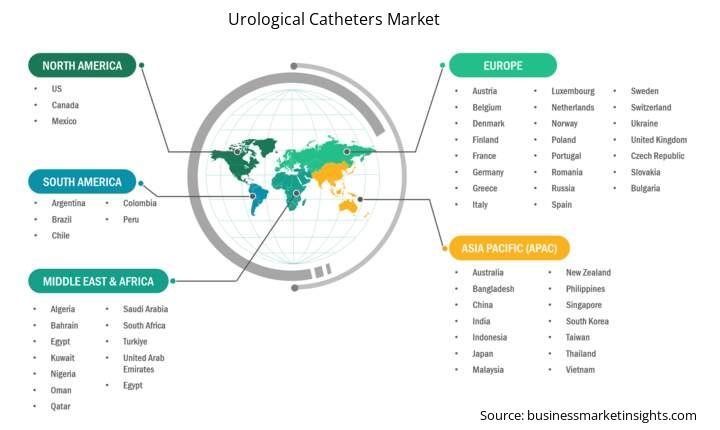Urological Catheters Market Outlook (2022-2033)
No. of Pages: 450 | Report Code: BMIPUB00031922 | Category: Life Sciences
No. of Pages: 450 | Report Code: BMIPUB00031922 | Category: Life Sciences
The urological catheters market size is expected to reach US$ 13,341.2 million by 2033 from US$ 6,633.9 million in 2024. The market is estimated to record a CAGR of 8.4% from 2025 to 2033.
The global urological catheters market is experiencing significant growth, driven by an aging population and a rising incidence of urinary incontinence and benign prostatic hyperplasia (BPH). The increased use of intermittent catheters in long-term care and rehabilitation, along with the growing preference for hydrophilic-coated and silicone catheters due to their reduced risk of urinary tract infections (UTIs), is also contributing to this market expansion.
However, the risk of catheter-associated infections and complications poses challenges to market growth. Geographically, North America holds the largest market share, largely due to the region's high burden of chronic illnesses. Meanwhile, the Asia Pacific area is emerging as the fastest-growing market, thanks to improvements in healthcare infrastructure and a growing patient population.
Prominent manufacturers of urological catheters, such as Medtronic Plc, Abbott Laboratories, and Boston Scientific Corp, are actively innovating products, forming partnerships, and driving market growth. As the demand for urological catheters increases, manufacturers are developing more sophisticated designs, which are expected to lower overall costs, enhance effectiveness, and ultimately improve patient outcomes globally.

Key segments that contributed to the derivation of the Urological Catheters market analysis are product, coating type, lumen, and end user.
Increased Use of Intermittent Catheters in Long-term Care and Rehabilitation
A significant factor driving the demand for intermittent catheters in urology is their increasing use in long-term care and rehabilitation settings. Intermittent catheters are designed to be inserted into the bladder to empty it and then removed immediately afterward. These catheters have shown advantages over indwelling or Foley catheters, particularly in preventing catheter-associated urinary tract infections (CAUTIs), which are a major complication in the long-term care population.
The rising older population, who are more likely to experience urinary incontinence and other urological-related conditions, further fuels the demand for these products. Additionally, innovative advancements in catheter designs, particularly hydrophilic intermittent catheters, have been found to be less painful upon insertion and reduce discomfort in the bladder.
The autonomy and self-care benefits associated with intermittent catheters also influence the choices of both patients and care staff in long-term care and rehabilitation programs. Furthermore, the growing reliance on home-based care models is enhancing the market for these products.
Innovation in Smart/Connected Catheters that Monitor Urine Flow or Detect Infections in Real Time
The advancement of smart or connected catheters, which can monitor urine flow and detect infections in real time, represents a significant opportunity for the urological catheters market. Traditional manual monitoring methods can be labor-intensive, inaccurate, and often delay the detection of critical conditions such as Acute Kidney Injury (AKI) or urinary tract infections (UTIs).
Smart catheters are equipped with integrated sensors and AI-powered systems that provide continuous, real-time, and accurate data on urine output and other important indicators. These catheters streamline healthcare providers' workflows, save valuable time, and enable more precise and timely diagnoses. This leads to earlier interventions and improved patient outcomes.
Additionally, smart catheters can wirelessly transmit data to electronic medical records (EMR) or mobile applications. This capability aligns with the growing trend of telemedicine and remote patient monitoring, extending the benefits and lifestyle improvements of smart catheters beyond the hospital setting to home care.
The urological catheters market is classified into several product categories, including Foley catheters, intermittent catheters, and others. Among these, the intermittent catheter represents the largest segment for several reasons. The most significant advantage of intermittent catheters is that they offer a safer and more convenient approach to bladder management compared to indwelling catheters. One of the key benefits of intermittent catheters is their ability to drastically reduce the risk of catheter-associated urinary tract infections (CAUTIs). Since indwelling catheters remain in the body for extended periods, they always pose a risk for infections. In contrast, patients using intermittent catheters only insert the device to drain urine from the bladder and then immediately remove it, which allows for a more natural voiding process and significantly lowers the chance of infection. Additionally, intermittent catheters enhance patient mobility.
As the prevalence of chronic conditions, including neurogenic bladder, urinary incontinence, and benign prostatic hyperplasia, continues to rise, especially among the rapidly growing geriatric population—the demand for catheters as a long-term management solution is increasing.
The urological catheters market is segmented by coating type into coated catheters and uncoated catheters. The coated catheter segment is significant and growing due to its essential role in improving patient comfort and minimizing complications. Long-term catheterization can lead to urethral trauma, pain, and increased risk of infections. Coated catheters address these issues effectively. They feature various coatings, such as hydrophilic materials that become smooth and slippery when exposed to water. This coating reduces friction during insertion and removal, decreasing the risk of urethral injury and discomfort. Furthermore, some coated catheters incorporate antimicrobial agents to hamper the growth of harmful bacteria on the catheter's surface, thereby significantly reducing the rate of CAUTIs. These innovations aim to enhance patient comfort, improve outcomes, and lower overall healthcare costs.
The urological catheters market is segmented by lumen type into single-lumen and multi-lumen categories. Among these, multi-lumen catheters represent the largest segment due to their inherent advantages, allowing for multiple functions to be performed simultaneously through a single catheter insertion. Multi-lumen designs are particularly useful for specific medical procedures. For example, some catheters contain one lumen dedicated to urine drainage and another for continuous bladder irrigation, which is often needed after prostate surgery to help flush the bladder. This dual functionality not only reduces the number of procedures required but also enhances patient comfort and provides clinicians with improved control and flexibility.
In terms of end users, the urological catheters market is divided into hospitals and clinics, home care settings, and others. As of 2024, hospitals and clinics held the largest market share for urological catheters. These facilities are the primary users of catheters because they conduct numerous medical and surgical procedures that necessitate catheterization. Catheters are commonly needed for patients undergoing elective surgeries, those arriving at emergency departments, and patients in intensive care units who require urinary drainage and output monitoring. Acute care facilities are equipped with the essential tools and trained healthcare professionals to perform catheterization procedures, manage any complications that arise, and monitor patients’ needs effectively in both the short and long term.
Urological Catheters Market Report Highlights
Report Attribute
Details
Market size in 2024
US$ 6,633.9 Million
Market Size by 2033
US$ 13,341.2 Million
Global CAGR (2025 - 2033) 8.4%
Historical Data
2022-2023
Forecast period
2025-2033
Segments Covered
By Product
By Coating Type
By Lumen
By End User
Regions and Countries Covered
North America
Europe
Asia-Pacific
South and Central America
Middle East and Africa
Market leaders and key company profiles
The "Urological Catheters Market Size and Forecast (2022–2033)" report provides a detailed analysis of the market covering below areas:

The geographical scope of the urological catheters market report is divided into five regions: North America, Asia Pacific, Europe, the Middle East and Africa, and South and Central America. The urological catheters market in the Asia Pacific is expected to witness substantial growth during the forecast period. This region encompasses countries such as China, Japan, India, South Korea, Australia, Bangladesh, New Zealand, the Philippines, Singapore, Indonesia, Taiwan, Malaysia, Vietnam, and other areas in Asia Pacific.
Asia Pacific is the fastest-growing region for urological catheters, driven by increased healthcare expenditures and improvements in healthcare infrastructure. As life expectancy rises, so does the incidence of urological disorders, including urinary incontinence, benign prostatic hyperplasia (BPH), and bladder dysfunction. The aging population is leading to higher demand for various types of catheters. Additionally, greater access to hospitals, clinics, and long-term care facilities, along with government initiatives to improve access, create opportunities for market development in the region.
China, India, and Japan are key growth markets within the Asia Pacific. China's growth is fueled by its large population and rapidly developing healthcare sector. The rapid expansion of the Chinese economy has led to increased investment in healthcare infrastructure and technology, driving the adoption of catheters. Additionally, China is facing a rising burden of chronic diseases and is enhancing its healthcare facilities.
India's market growth is attributed to its large and rapidly growing population, as well as a surging burden of chronic diseases and advancement in healthcare infrastructure. The rise in medical tourism and patient-centric care also contributes to market growth. Meanwhile, Japan, although a mature market, is experiencing growth due to its high percentage of elderly individuals. The demand for urological catheters in Japan is primarily driven by the need for high-quality, safe, and comfortable catheters suitable for long-term care.
The urological catheters market is evaluated by gathering qualitative and quantitative data post primary and secondary research, which includes important corporate publications, association data, and databases. A few of the key developments in the Urological Catheters market are:
The Urological Catheters Market is valued at US$ 6,633.9 Million in 2024, it is projected to reach US$ 13,341.2 Million by 2033.
As per our report Urological Catheters Market, the market size is valued at US$ 6,633.9 Million in 2024, projecting it to reach US$ 13,341.2 Million by 2033. This translates to a CAGR of approximately 8.4% during the forecast period.
The Urological Catheters Market report typically cover these key segments-
The historic period, base year, and forecast period can vary slightly depending on the specific market research report. However, for the Urological Catheters Market report:
The Urological Catheters Market is populated by several key players, each contributing to its growth and innovation. Some of the major players include:
The Urological Catheters Market report is valuable for diverse stakeholders, including:
Essentially, anyone involved in or considering involvement in the Urological Catheters Market value chain can benefit from the information contained in a comprehensive market report.